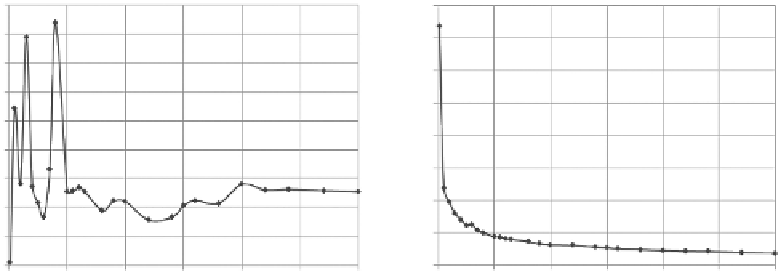Environmental Engineering Reference
In-Depth Information
(a)
9
(b)
240
210
180
8
7
6
5
4
150
120
90
60
30
0
3
2
1
0
0
500
1000
1500
2000
2500
3000
0
500
1000
1500
2000
2500
3000
N
s
N
s
Figure 15.3 Pf
f
and COV(
P
f
) versus the number of realizations
N
s
.
COV
Pf
. As expected, COV
Pf
decreases with increasing
N
s
. Notice that the values of COV
Pf
for
N
s
= 2200 and 2400 samples are equal to 12.8 and 12.4%, respectively, which indicates
(as expected) that the COV
Pf
decreases with the increase in the number of realizations.
It should be mentioned here that for
p
0
= 0.2, four levels of SS were found necessary
to reach the limit state surface
G
= 0 as may be seen from
Table 15.6
.
Therefore, when
N
s
= 2200 samples, a total number of
N
t
= 2200 × 4 = 8800 samples were required to calcu-
late the final
P
f
value. Remember that in this case, the COV of
P
f
was equal to 12.8%. Notice
that if the same value of COV (i.e., 12.8%) is desired by MCS to calculate
P
f
, the number of
samples would be equal to 20,000. This means that, for the same accuracy, the SS approach
reduces the number of realizations by 56%. On the other hand, if one uses MCS with the
same number of samples (i.e., 8800 realizations), the value of COV of
P
f
would be equal
to 19.6%. This means that for the same computational effort, the SS approach provides a
smaller value of COV(
P
f
) than MCS.
15.5.3 example 3: Computation of the failure probability
by an SS approach in the case of random fields
This section presents a probabilistic analysis at the serviceability limit state (SLS) of a strip
footing resting on a spatially varying soil using the SS approach. The objective is the compu-
tation of the probability
P
e
of exceeding a tolerable vertical displacement under a prescribed
footing load. Only one soil variability (
l
ln
x
= 10 m and
l
ln
y
= 1 m) is considered in this sec-
tion. An extensive probabilistic parametric study on the same problem may be found in
Ahmed and Soubra (2012).
A footing of breadth
b
= 2 m that is subjected to a central vertical load
P
s
= 1000 kN/m
(i.e., an applied uniform vertical pressure
q
s
= 500 kN/m
2
) was considered in the analysis.
As in Example 1, the Young's modulus was modeled by a random field and it was assumed
to follow a log-normal PDF. The mean value and the coefficient of variation of the Young's
modulus were, respectively, μ
E
= 60 MPa and COV
E
= 15%. An exponential covariance
function was used to represent the correlation structure of the random field. The random
field was discretized using K-L expansion. The performance function used to calculate the
probability
P
e
of exceeding a tolerable vertical displacement was defined as follows:
G = δ
v
max
− δ
v
(15.21)

Search WWH ::

Custom Search